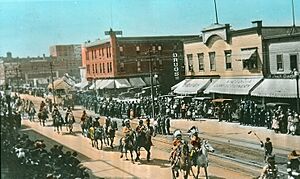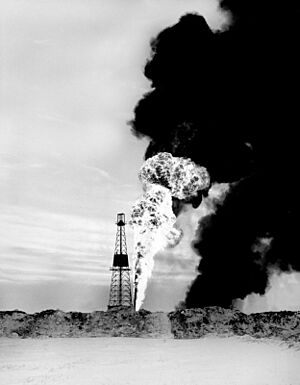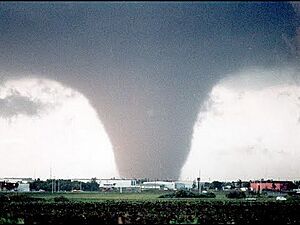History of Edmonton facts for kids

The area that is now Edmonton, Alberta, Canada, has been home to people for a very long time. The first inhabitants were hunters and gatherers who lived here around 3,000 BC. Some experts even think people might have been here as early as 10,000 BC. This was when the last ice age was ending, and the land became free of ice, offering trees, water, and wildlife for people to use.
Contents
Edmonton's Early History
Like many places in North America, Edmonton has a long history of First Nations groups living on this land for thousands of years.
The Fur Trade Era
In 1795, European traders from the North West Company (NWC) built a trading post called Fort Augustus north of where Edmonton is today. A year later, their rivals, the Hudson's Bay Company (HBC), built their own post called Edmonton House (which later became Fort Edmonton) right next to Fort Augustus. Both companies were competing in the North American fur trade.
Over time, these forts moved a few times. In 1802, they moved about 30 kilometers (18 miles) south to the Rossdale Flats, which is near downtown Edmonton today. They briefly moved north again before returning to Rossdale Flats in 1813. When the Hudson's Bay Company and the North West Company joined together in 1821, Fort Augustus was no longer needed. All the trading was then done at Fort Edmonton. This fort became an important center for the fur trade in the North Saskatchewan District of Rupert's Land.
The Rossdale location was used until 1830. Flooding forced the building of a new Fort Edmonton on higher ground. This new fort was built where the Alberta Legislature Building stands today. As the fur trade became less important in the 1860s, many buildings at Fort Edmonton were left empty. The fort was finally taken apart in 1915.
Growing as a Settlement (1870–1945)
The first homes outside the fort appeared in the 1870s. Pioneer farmers built simple log cabins along the river. These farms helped shape how the land was divided in 1882. Today, "1885 Street" at Fort Edmonton Park shows what the early village of Edmonton was like. The Town of Edmonton was officially created in 1894. It included areas like Boyle Street (the original downtown) and McCauley.
In 1870, the Hudson's Bay Company owned a large area of what is now downtown. But by 1913, during a time when land prices were very high, they had sold it all off. The Calgary and Edmonton Railway was finished in 1891. However, it didn't come directly into Edmonton. Instead, Strathcona was built on the south side of the river where the railway ended. Strathcona became a town in 1899.
Edmonton got its first railway connection in 1903. The Edmonton, Yukon and Pacific Railway was built from Strathcona, crossing the river on the Low Level Bridge. Edmonton officially became a city in 1904. Soon after, with only about 5,000 people, it was named the capital of Alberta. Edmonton gained a direct railway link to Winnipeg in 1905. Another line to Vancouver opened in 1915. Strathcona also became a city in 1907.
With new land available west of what is now 100 Street, Edmonton grew a lot. The old downtown area of Boyle Street was replaced by the new, current downtown. Many new communities like Glenora, Highlands, and Westmount were built as the economy boomed. In the early 1910s, Edmonton grew very quickly, causing real estate prices to skyrocket. In 1912, Edmonton joined with the city of Strathcona. This meant the city now stretched south of the river.
Just before World War I, the real estate boom suddenly ended. The city's population dropped sharply, from over 72,500 in 1914 to under 54,000 just two years later. Many people joined the army during the war, which also contributed to the population drop. The city slowly grew in population and economy during the 1920s and 1930s. Then, during and after World War II, it really took off.
Canada's first licensed airfield, Blatchford Field (later called Edmonton City Centre (Blatchford Field) Airport), started operating in 1926. Brave pilots like Wilfrid R. "Wop" May and Max Ward used Blatchford Field as a main base. From here, they delivered mail, food, and medicine to Northern Canada. This helped Edmonton become known as the "Gateway to the North." During World War II, Edmonton became a major base for building the Alaska Highway and the Northwest Staging Route.
Edmonton After World War II

A huge discovery of oil in Alberta happened on February 13, 1947, near the town of Leduc, just south of Edmonton. While some oil had been found in southern Alberta before, the Leduc discovery was much bigger. More oil was found in the late 1940s and 1950s near Redwater. Because most of Alberta's oil was in the central and northern parts of the province, Edmonton became the center for much of Alberta's oil industry.
This "oil boom" gave Edmonton a new nickname: the "Oil Capital of Canada." During the 1950s, the city's population grew rapidly from 149,000 to 269,000. After a quieter but still successful period in the 1960s, the city's growth picked up again. This was due to high world oil prices, especially after the 1973 oil crisis and the 1979 Iranian Revolution.
The oil boom of the 1970s and 1980s ended suddenly when oil prices dropped sharply in 1986. The city's population had reached 521,000 in 1981. It took until the late 1990s for the city to fully recover economically.
In 1981, West Edmonton Mall opened. At the time, it was the largest mall in the world. It is still the biggest in North America and is a very popular tourist spot in Alberta. The mall has an indoor amusement park, a large indoor waterpark, a skating rink, a full-size copy of the Santa María ship, many restaurants and bars, and a fancy hotel. Plus, it has over 700 shops and services.
Edmonton lost some of its passenger train routes in the 1980s. Via Rail stopped service to Drumheller in 1981 and to Calgary in 1985.

On July 31, 1987, a very powerful tornado (ranked F4 on the Fujita scale) hit the city. The storm caused widespread damage in areas like Beaumont, Mill Woods, Bannerman, Fraser, and Evergreen. This day became known as "Black Friday." The mayor at the time, Laurence Decore, saw how the community came together to help each other after the tornado. He said it showed Edmonton was a "city of champions." This phrase became popular, especially after the Edmonton Eskimos winning the Grey Cup and the Edmonton Oilers won the Stanley Cup in 1987.
The city's economy began to recover and thrive again in the late 1990s. This was helped by stronger oil prices and the city's economy becoming more diverse. While oil production and refining still provide many jobs, Edmonton's economy has grown in other areas, such as high-tech jobs. Downtown Edmonton and parts of the inner city, which had struggled for years, have improved greatly. More people are choosing to live in or near the downtown area, even though new neighborhoods are still growing on the city's edges.
Edmonton in the 21st Century

In recent years, downtown Edmonton has seen a lot of new development. Streets like Jasper Avenue and 104 Street now have many clubs, shops, restaurants, and art galleries. Much of this growth was encouraged by the building of Rogers Place. The new Art Gallery of Alberta opened downtown in January 2010. The EPCOR Tower, the first new office tower in 22 years, was completed in 2010. The Icon Towers, finished in 2010, were the tallest residential buildings in the city for a while, until The Pearl was completed in 2015. Many other tall condo buildings are still being built downtown.
Outside the city center, new residential areas are also being developed. These include places like Big Lake, Ellerslie, The Grange, Heritage Valley, Lewis Farms, The Meadows, The Palisades, Pilot Sound, and Windermere. New shopping centers are also being built in areas like The Meadows and Windermere.
This strong economy is bringing many new workers to Edmonton from all over Canada. It was predicted that 83,000 new residents would move to Edmonton between 2006 and 2010, which was twice as many as city planners expected. Many of these new workers are young men.
In 2008, the Edmonton metropolitan area grew to over one million people. This made it the most northern city in North America with a metropolitan population of over one million.
In 2016, a new arena called Rogers Place opened as part of the downtown's Ice District. In the same year, the final section of the Anthony Henday Drive (a highway that goes around the city) was completed. Edmonton is the first city in Canada to have a highway ring road that is completely free-flowing, meaning no traffic lights.
In 2018, the Stantec Tower was finished. It became the tallest building in Canada outside of Toronto.
See also
- Edmonton annexations
- History of Alberta
- Timeline of Edmonton history





